The Effect of pH on the Electrodeposition of Pd Clusters onto Highly Ordered Pyrolytic Graphite—A Kinetic and Morphological Study
Abstract
1. Introduction
2. Materials and Methods
3. Results and Discussion
3.1. Thermodynamic Study
3.2. Voltamperometric Study
3.3. Chronoamperometric Study
Analysis of the Kinetic Parameters
3.4. Morphological Study
4. Conclusions
Author Contributions
Funding
Data Availability Statement
Acknowledgments
Conflicts of Interest
References
- Cookson, J. The Preparation of Palladium Nanoparticles. Platin. Met. Rev. 2012, 56, 83–98. [Google Scholar] [CrossRef]
- Hernando, A.; Sampedro, B.; Garcia, M.A.; Marin, P.; Rivero, G.; Crespo, P.; Gonzalez, J.M. Palladium: A Localised Paramagnetism. arXiv 2006, arXiv:cond-mat/0605496. [Google Scholar]
- Shoji, H. Platinum and Palladium in Magnetic Storage Applications. Physics 1994, 38, 164–165. [Google Scholar]
- Besenhard, J.O.; Krebber, U. A STM Study of Pd-Catalyst for Electroless Cu Deposition on Nonconductors by Means of a Modified Graphite Substrate. J. Electrochem. Soc. 1989, 136, 3608–3610. [Google Scholar] [CrossRef]
- Sartre, A.; Phaner, M.; Porte, L.; Sauvion, G.N. STM and ESCA Studies of Palladium Particles Deposited on a HOPG Surface. Appl. Surf. Sci. 1993, 70–71, 402–406. [Google Scholar] [CrossRef]
- Granjeaud, S.; Yckache, K.; Dayez, M.; Humbert, A.; Chapon, C.; Henry, C.R. STM/TEM Comparative Study of Pd Clusters Epitaxially Grown on Highly Oriented Pyrolytic Graphite. Microsc. Microanal. Microstruct. 1993, 4, 409–418. [Google Scholar] [CrossRef]
- Humbert, A.; Dayez, M.; Granjeaud, S.; Ricci, P.; Chapon, C.; Henry, C.R. Ultrahigh Vacuum and Air Observations of Pd Clusters Grown on Clean Graphite. J. Vac. Sci. Technol. B Microelectron. Nanom. Struct. 1991, 9, 804. [Google Scholar] [CrossRef]
- Cadete Santos Aires, F.J.; Sautet, P.; Fuchs, G.; Rousset, J.-L.; Mélinon, P. Model Catalysts Obtained by Cluster Deposition of Palladium onto HOPG. TEM and STM Characterisation. Microsc. Microanal. Microstruct. 1993, 4, 441–452. [Google Scholar] [CrossRef]
- Erlandsson, R.; Eriksson, M.; Olsson, L.; Helmersson, U.; Lundström, I.; Petersson, L.-G. Gas-Induced Restructuring of Palladium Model Catalysts Studied with Atomic Force Microscopy. J. Vac. Sci. Technol. B Microelectron. Nanom. Struct. 1991, 9, 825. [Google Scholar] [CrossRef]
- Murakami, Y.; Naoi, K.; Yahikozawa, K.; Takasu, Y. High-Resolution Images of Pd Particles Supported on Highly Oriented Pyrolytic Graphite and Glassy Carbon. J. Electrochem. Soc. 1994, 141, 2511. [Google Scholar] [CrossRef]
- Alemu, T.; Assresahegn, B.D.; Soreta, T.R. Tuning the Initial Electronucleation Mechanism of Palladium on Glassy Carbon Electrode. Port. Electrochim. Acta 2014, 32, 21–33. [Google Scholar] [CrossRef]
- Chang, G.; Luo, Y.; Lu, W.; Qin, X.; Asiri, A.M.; Al-youbi, A.O.; Sun, X. Electrodeposition Fabrication of Pd Nanoparticles on Glassy Carbon Electrode. Curr. Res. Nanotechnol. 2013, 4, 1–7. [Google Scholar] [CrossRef][Green Version]
- Danaee, I.; Shoghi, F.; Dehghani Mobarake, M.; Kameli, M. Electrocrystallization of Palladium from Pd(NH3)4Cl2 Bath on Stainless Steel 316L. J. Solid State Electrochem. 2010, 14, 57–62. [Google Scholar] [CrossRef]
- Diculescu, V.C.; Chiorcea-Paquim, A.M.; Corduneanu, O.; Oliveira-Brett, A.M. Palladium Nanoparticles and Nanowires Deposited Electrochemically: AFM and Electrochemical Characterization. J. Solid State Electrochem. 2007, 11, 887–898. [Google Scholar] [CrossRef]
- Fuentes, A.S.; Filippin, A.F.; Aguirre, M.d.C. Pd Nucleation and Growth Mechanism Deposited on Different Substrates. Procedia Mater. Sci. 2015, 8, 541–550. [Google Scholar] [CrossRef]
- Wang, C.; Ren, F.; Zhai, C.; Zhang, K.; Yang, B.; Bin, D.; Wang, H.; Yang, P.; Du, Y. Au-Cu-Pt Ternary Catalyst Fabricated by Electrodeposition and Galvanic Replacement with Superior Methanol Electrooxidation Activity. RSC Adv. 2014, 4, 57600–57607. [Google Scholar] [CrossRef]
- Heydari, H.; Abdolmaleki, A.; Gholivand, M.B. Electrodeposition and Characterization of Palladium Nanostructures on Stainless Steel and Application as Hydrogen Sensor. Ciênc. Nat. 2015, 37, 23–33. [Google Scholar] [CrossRef]
- Kim, K.; Kim, M.; Cho, S.M. Pulsed Electrodeposition of Palladium Nanowire Arrays Using AAO Template. Mater. Chem. Phys. 2006, 96, 278–282. [Google Scholar] [CrossRef]
- Kublanovsky, V.S.; Nikitenko, V.N.; Rudenko, K.P. Electrodeposition of Palladium Coatings from Iminodiacetate Electrolyte. Am. J. Anal. Chem. 2013, 2013, 642–646. [Google Scholar] [CrossRef]
- Le Penven, R.; Levason, W.; Pletcher, D. Studies of the Electrodeposition of Palladium from Baths Based on [Pd(NH3)2X2] Salts. I. [Pd(NH3)2Cl2] Baths. J. Appl. Electrochem. 1990, 20, 399–404. [Google Scholar] [CrossRef]
- Lee, J.W.; Ju, J.B.; Kim, J.D. Electrodeposition of Palladium on the Copper Lead Frame: Electrode Reaction Characteristics and the Effects of Primary Additives. Korean J. Chem. Eng. 2007, 24, 960–964. [Google Scholar] [CrossRef]
- Bravo-Rodriguez, A.S.; Álvarez-Romero, G.A.; Rivera, M.; García-Sánchez, E.; Mendoza-Huizar, L.H. Palladium Electrodeposition Onto a Carbon Fiber Ultramicroelectrode. Croat. Chem. Acta 2022, 95, 49–55. [Google Scholar] [CrossRef]
- Mendoza-Huizar, L.H.; Garrido-Márquez, D.; Rios-Reyes, C.H.; Rivera, M.; García-Sánchez, E.; Galán-Vidal, C. A Kinetic and AFM Study of the Electrodeposition of Palladium Nanoclusters onto Highly Oriented Pyrolytic Graphite (HOPG). J. Clust. Sci. 2015, 26, 337–346. [Google Scholar] [CrossRef]
- Le Penven, R.; Levason, W.; Pletcher, D. Studies of Palladium Electrodeposition from Baths Based on Pd (NH3) 2X2 Part II: X = Br and X = NO2. J. Appl. Electrochem. 1992, 22, 421–424. [Google Scholar] [CrossRef]
- Rezaei, M.; Tabaian, S.H.; Haghshenas, D.F. Electrochemical Nucleation of Palladium on Graphene: A Kinetic Study with an Emphasis on Hydrogen Co-Reduction. Electrochim. Acta 2013, 87, 381–387. [Google Scholar] [CrossRef]
- Abys, J.A. Palladium Electroplating. In Modern Electroplating; John Wiley & Sons, Inc.: Hoboken, NJ, USA, 2011; pp. 327–368. [Google Scholar] [CrossRef]
- Rao, C.R.K.; Trivedi, D.C. Chemical and Electrochemical Depositions of Platinum Group Metals and Their Applications. Coord. Chem. Rev. 2005, 249, 613–631. [Google Scholar] [CrossRef]
- Martell, A.E.; Smith, R.M. Critical Stability Constants; Springer: CollegeStation, TX, USA, 1976; Volume 4. [Google Scholar]
- Platt, M.; Dryfe, R.A.W.; Roberts, E.P.L. Structural and Electrochemical Characterisation of Pt and Pd Nanoparticles Electrodeposited at the Liquid/Liquid Interface. Electrochim. Acta 2004, 49, 3937–3945. [Google Scholar] [CrossRef]
- Pinheiro, A.L.N.; Zei, M.S.; Luo, M.F.; Ertl, G. The Epitaxial Growth of Pd Electrodeposition on Au(1 0 0) Studied by LEED and RHEED. Surf. Sci. 2006, 600, 641–650. [Google Scholar] [CrossRef]
- Duncan, H.; Lasia, A. Mechanism of Hydrogen Adsorption/Absorption at Thin Pd Layers on Au(1 1 1). Electrochim. Acta 2007, 52, 6195–6205. [Google Scholar] [CrossRef]
- Baldauf, M.; Kolb, D.M. Formic Acid Oxidation on Ultrathin Pd Films on Au(Hkl) and Pt(Hkl) Electrodes. J. Phys. Chem. 1996, 100, 11375–11381. [Google Scholar] [CrossRef]
- Naohara, H.; Ye, S.; Uosaki, K. Electrochemical Layer-by-Layer Growth of Palladium on an Au(111) Electrode Surface: Evidence for Important Role of Adsorbed Pd Complex. J. Phys. Chem. B 1998, 102, 4366–4373. [Google Scholar] [CrossRef]
- Xu, D.; Yan, X.; Diao, P.; Yin, P. Electrodeposition of Vertically Aligned Palladium Nanoneedles and Their Application as Active Substrates for Surface-Enhanced Raman Scattering. J. Phys. Chem. C 2014, 118, 9758–9768. [Google Scholar] [CrossRef]
- Kim, B.-K.; Seo, D.; Lee, J.Y.; Song, H.; Kwak, J. Electrochemical Deposition of Pd Nanoparticles on Indium-Tin Oxide Electrodes and Their Catalytic Properties for Formic Acid Oxidation. Electrochem. Commun. J. 2010, 12, 1442–1445. [Google Scholar] [CrossRef]
- Gupta, R.; Guin, S.K.; Aggarwal, S.K. Electrocrystallization of Palladium (Pd) Nanoparticles on Platinum (Pt) Electrode and Its Application for Electro-Oxidation of Formic Acid and Methanol. Electrochim. Acta 2014, 116, 314–320. [Google Scholar] [CrossRef]
- Ilias, S.H.; Kok, K.Y.; Ng, I.K.; Saidin, N.U. Related Content Fabrication of Au/Ni Multilayered Nanowires by Electrochemical Deposition Electrochemical Synthesis and Characterization of Palladium Nanostructures. J. Phys. Conf. Ser. Electrochem. 2013, 431, 012003. [Google Scholar] [CrossRef]
- Habibi, B. Aluminum Supported Palladium Nanoparticles: Preparation, Characterization and Application for Formic Acid Electrooxidation. Int. J. Hydrogen Energy 2013, 38, 5464–5472. [Google Scholar] [CrossRef]
- Modibedi, R.M.; Louw, E.; Mathe, M.K.; Ozoemena, K.I. The Electrochemical Atomic Layer Deposition of Pt and Pd Nanoparticles on Ni Foam for the Electro-Oxidation of Alcohols. ECS Trans. 2013, 50, 9–18. [Google Scholar] [CrossRef]
- Maringa, A.; Nyokong, T. Behavior of Palladium Nanoparticles in the Absence or Presence of Cobalt Tetraaminophthalocyanine for the Electrooxidation of Hydrazine. Electroanalysis 2014, 26, 1068–1077. [Google Scholar] [CrossRef]
- Rezaei, M.; Tabaian, S.H.; Haghshenas, D.F. Nucleation and Growth of Pd Nanoparticles during Electrocrystallization on Pencil Graphite. Electrochim. Acta 2012, 59, 360–366. [Google Scholar] [CrossRef]
- Danaee, I. 2D–3D Nucleation and Growth of Palladium on Graphite Electrode. J. Ind. Eng. Chem. 2013, 19, 1008–1013. [Google Scholar] [CrossRef]
- Rezaei, M.; Tabaian, S.H.; Haghshenas, D.F. A Kinetic Description of Pd Electrodeposition under Mixed Control of Charge Transfer and Diffusion. J. Electroanal. Chem. 2012, 687, 95–101. [Google Scholar] [CrossRef]
- Nayelli Escobar-Muñoz, A.C.-G.; Hernandez, M.M. Palladium Electrodeposition on Carbon Paste Electrodes: Early Stages of Nucleation and Growth. In Theoretical and Experimental Advances in Electrodeposition; Humberto Mendoza Huizar, L., Ed.; Research Signpost: Kerala, India, 2008; pp. 89–100. [Google Scholar]
- Sun, Y.; Wang, H.H. Electrodeposition of Pd Nanoparticles on Single-Walled Carbon Nanotubes for Flexible Hydrogen Sensors. Appl. Phys. Lett. 2007, 90, 213107. [Google Scholar] [CrossRef]
- Gioia, D.; Casella, I.G. Pulsed Electrodeposition of Palladium Nano-Particles on Coated Multi-Walled Carbon Nanotubes/Nafion Composite Substrates: Electrocatalytic Oxidation of Hydrazine and Propranolol in Acid Conditions. Sens. Actuators B Chem. 2016, 237, 400–407. [Google Scholar] [CrossRef]
- Dean, J.A. Handbook of Chemistry, 15th ed.; McGraw-Hill, Inc.: New York, NY, USA, 1999. [Google Scholar] [CrossRef]
- Puigdomenech, I. HYDRA (Hydrochemical Equilibrium- Constant Database) and MEDUSA (Make Equilibrium Diagrams Using Sophisticated Algorithms) Programs. KTH Royal Institute of Technology: Stockholm, Sweden. 2004. Available online: https://www.scirp.org/reference/referencespapers?referenceid=612203 (accessed on 11 April 2024).
- Baumgaertner, M.E. The Electrodeposition of Palladium Iron Alloys. Loughborough University. Available online: https://repository.lboro.ac.uk/articles/thesis/The_electrodeposition_of_palladium_iron_alloys/9233519 (accessed on 26 April 2024).
- De Almeida, C.S.; Miccoli, L.S. Palladium Electrolytic Bath and Method of Making and Using Same. EP0107308, 8 September 1983. [Google Scholar]
- Karadurmus, L.; Kurbanoglu, S.; Uslu, B.; Ozkan, S.A. An Efficient, Simultaneous Electrochemical Assay of Rosuvastatin and Ezetimibe from Human Urine and Serum Samples. Methods Protoc. 2022, 5, 90. [Google Scholar] [CrossRef] [PubMed]
- Berzins, T.; Delahay, P. Oscillographic Polarographic Waves for the Reversible Deposition of Metals on Solid Electrodes. J. Am. Chem. Soc. 1953, 75, 555–559. [Google Scholar] [CrossRef]
- Bard, A.J.; Faulkner, L.R. Electrochemical Methods and Applications, 2nd ed.; John Wiley & Sons, Ltd.: Hoboken, NJ, USA, 2001. [Google Scholar]
- Hong-Ru, Z.; Yun-Dan, Y.; Guo-Ying, W.; Hong-Liang, G. FePt Thin Films Electrodeposited from Non-Aqueous Liquids. Int. J. Electrochem. Sci. 2012, 7, 5544–5556. [Google Scholar] [CrossRef]
- Liu, S.; Wei, Y.; Liu, R.; Fang, B. Electrochemical Behavior and Electrowinning of Palladium in Nitric Acid Media. Sci. China Chem. 2013, 56, 1743–1748. [Google Scholar] [CrossRef]
- Sluyters-Rehbach, M.; Wijenberg, J.H.O.J.; Bosco, E.; Sluyters, J.H. The Theory of Chronoamperometry for the Investigation of Electrocrystallization: Mathematical Description and Analysis in the Case of Diffusion-Controlled Growth. J. Electroanal. Chem. Interfacial Electrochem. 1987, 236, 1–20. [Google Scholar] [CrossRef]
- Scharifker, B.R.; Mostany, J.; Palomar-Pardavé, M.; González, I. On the Theory of the Potentiostatic Current Transient for Diffusion-Controlled Three-Dimensional Electrocrystallization Processes. J. Electrochem. Soc. 1999, 146, 1005. [Google Scholar] [CrossRef]
- Heerman, L.; Tarallo, A. Theory of the Chronoamperometric Transient for Electrochemical Nucleation with Diffusion-Controlled Growth. J. Electroanal. Chem. 1999, 470, 70–76. [Google Scholar] [CrossRef]
- Scharifker, B.; Hills, G. Theoretical and Experimental Studies of Multiple Nucleation. Electrochim. Acta 1983, 28, 879–889. [Google Scholar] [CrossRef]
- Palomar-Pardavé, M.; Scharifker, B.R.; Arce, E.M.; Romero-Romo, M. Nucleation and Diffusion-Controlled Growth of Electroactive Centers: Reduction of Protons during Cobalt Electrodeposition. Electrochim. Acta 2005, 50, 4736–4745. [Google Scholar] [CrossRef]
- Gimeno, Y.; Hernández Creus, A.; Carro, P.; González, S.; Salvarezza, R.C.; Arvia, A.J. Electrochemical Formation of Palladium Islands on HOPG: Kinetics, Morphology, and Growth Mechanisms. J. Phys. Chem. B 2002, 106, 4232–4244. [Google Scholar] [CrossRef]
- Espino-López, I.E.; Romero-Romo, M.; de Oca-Yemha, M.G.M.; Morales-Gil, P.; Ramírez-Silva, M.T.; Mostany, J.; Palomar-Pardavé, M. Palladium Nanoparticles Electrodeposition onto Glassy Carbon from a Deep Eutectic Solvent at 298 K and Their Catalytic Performance toward Formic Acid Oxidation. J. Electrochem. Soc. 2019, 166, D3205–D3211. [Google Scholar] [CrossRef]
- Thao, D.V.P.; Ngan, D.T.T.; Van Tuan, D.; Lan, H.; Nguyet, N.T.; Dien, N.D.; Van Thu, V.; Vuong, P.H.; Tam, P.D. Study on the Palladium Nucleation and Growth Mechanism in A Deep Eutectic Solvent by Electrochemical Method. VNU J. Sci. Math. Phys. 2024, 40, 18–31. [Google Scholar] [CrossRef]
- Rivera, M.; Rios-Reyes, C.H.; Mendoza-Huizar, L.H. Morphological and Magnetic Properties of Cobalt Nanoclusters Electrodeposited onto HOPG. Appl. Surf. Sci. 2008, 255, 1754–1758. [Google Scholar] [CrossRef]
- Milchev, A. Electrocrystallization. Fundamentals of Nucleation and Growth, 1st ed.; Kluwer Academic Publishers: NewYork, NY, USA, 2002; Volume 1. [Google Scholar] [CrossRef]
- Noel, M.; Vasu, K.I. Cyclic Voltammetry and the Frontiers of Electrochemistry; Aspect Publications, Ed.; Aspect: London, UK, 1990. [Google Scholar]
- Haghighat, S.; Dawlaty, J.M. PH Dependence of the Electron-Transfer Coefficient: Comparing a Model to Experiment for Hydrogen Evolution Reaction. J. Phys. Chem. C 2016, 120, 28489–28496. [Google Scholar] [CrossRef]
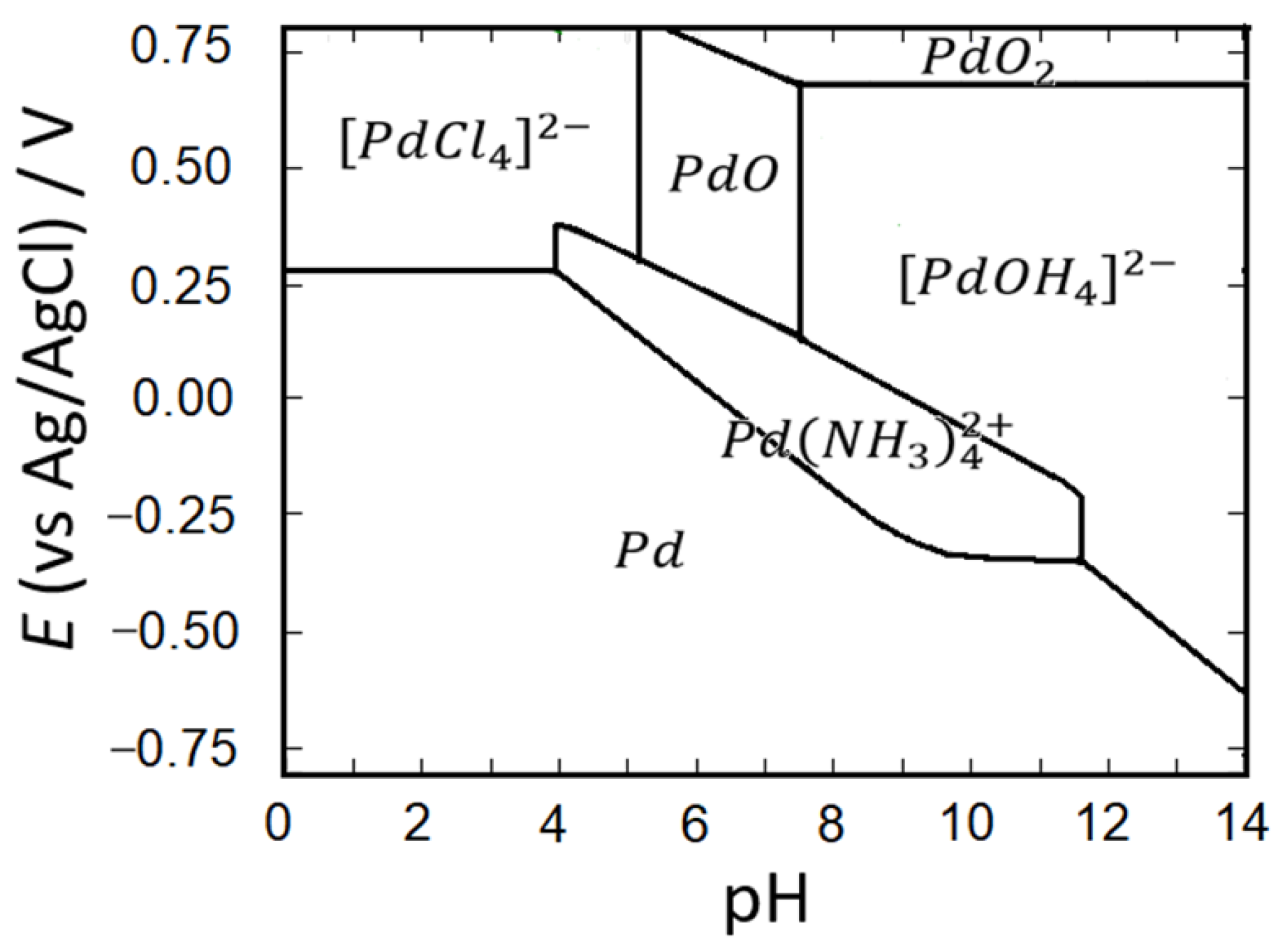
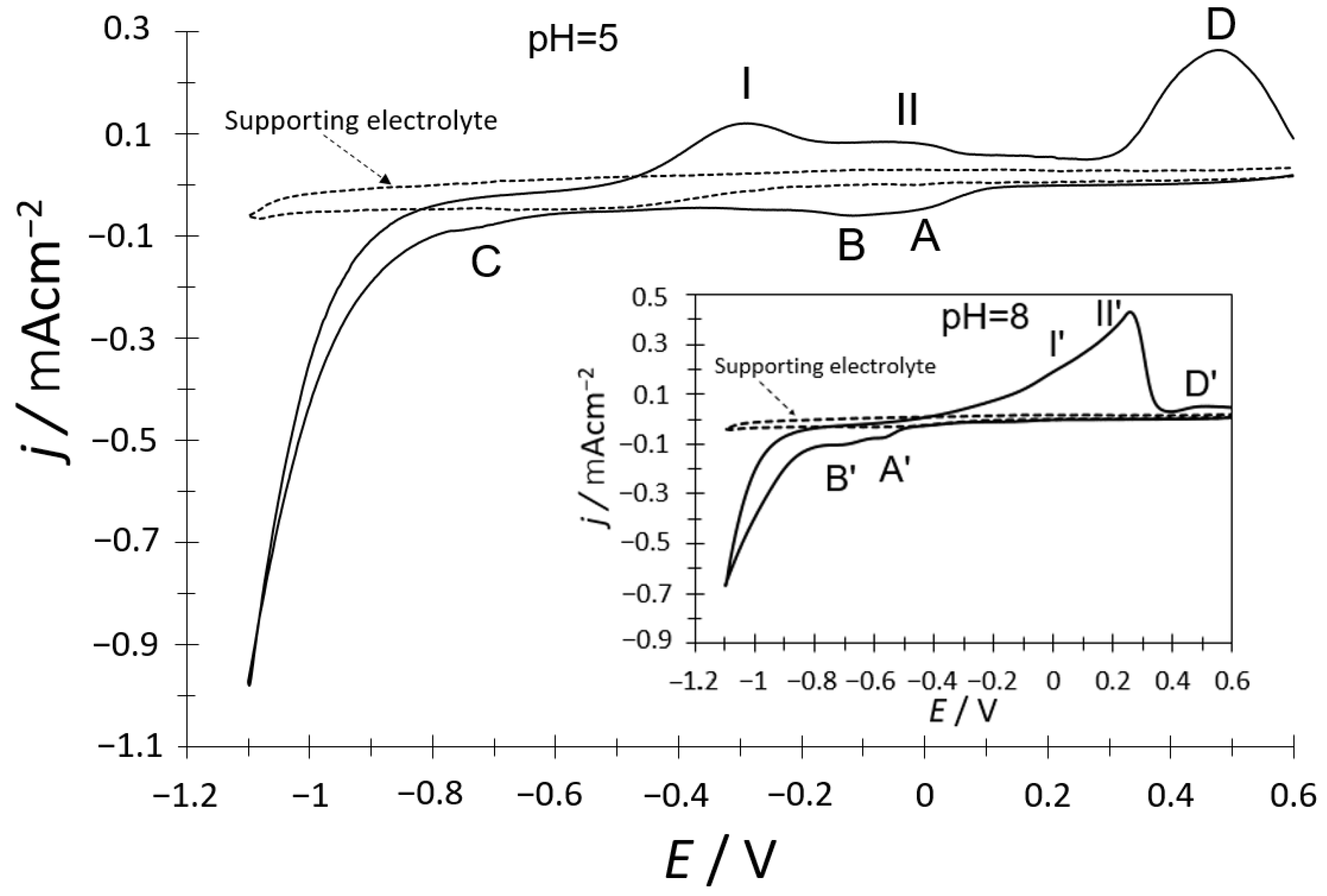
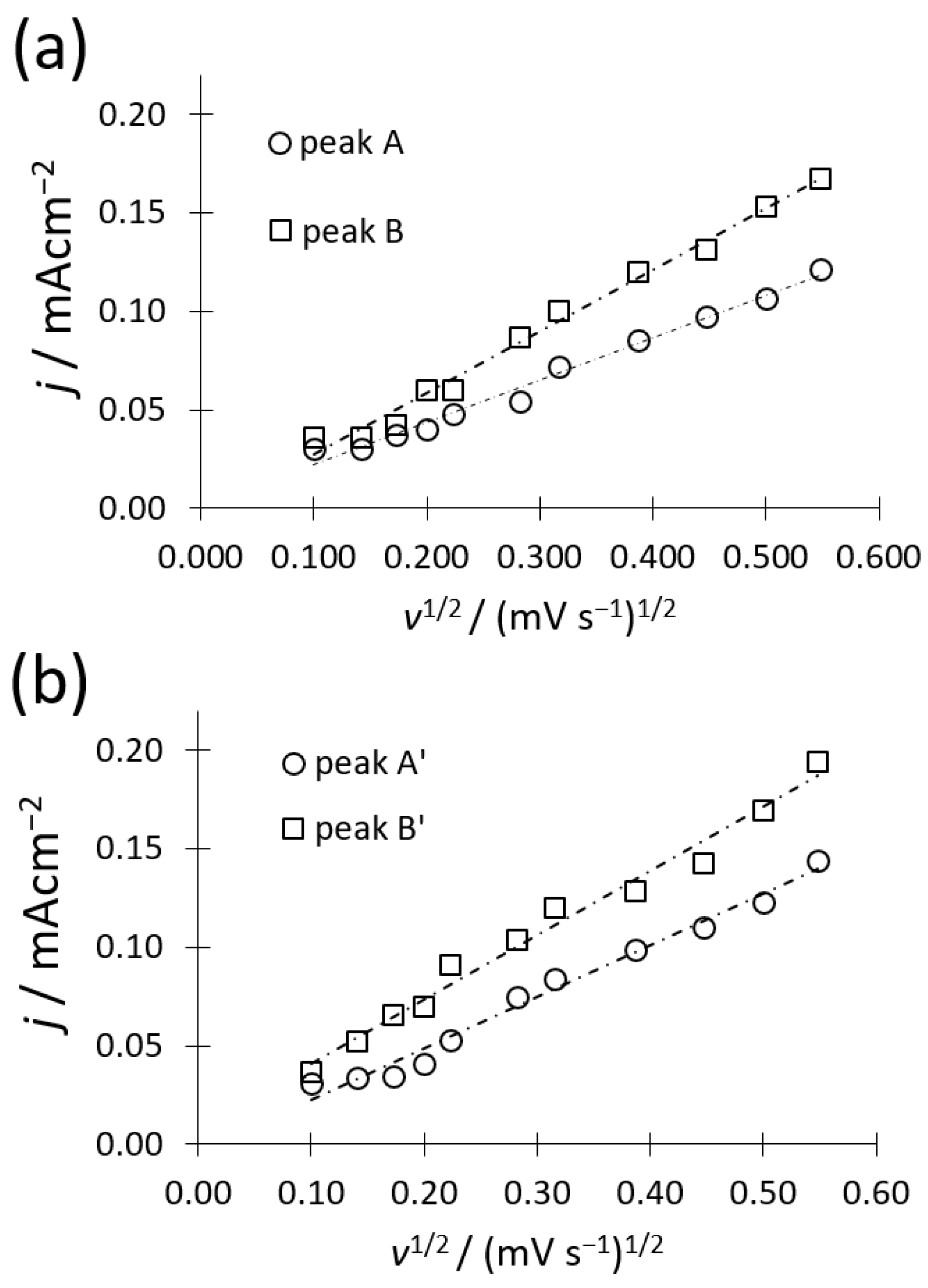
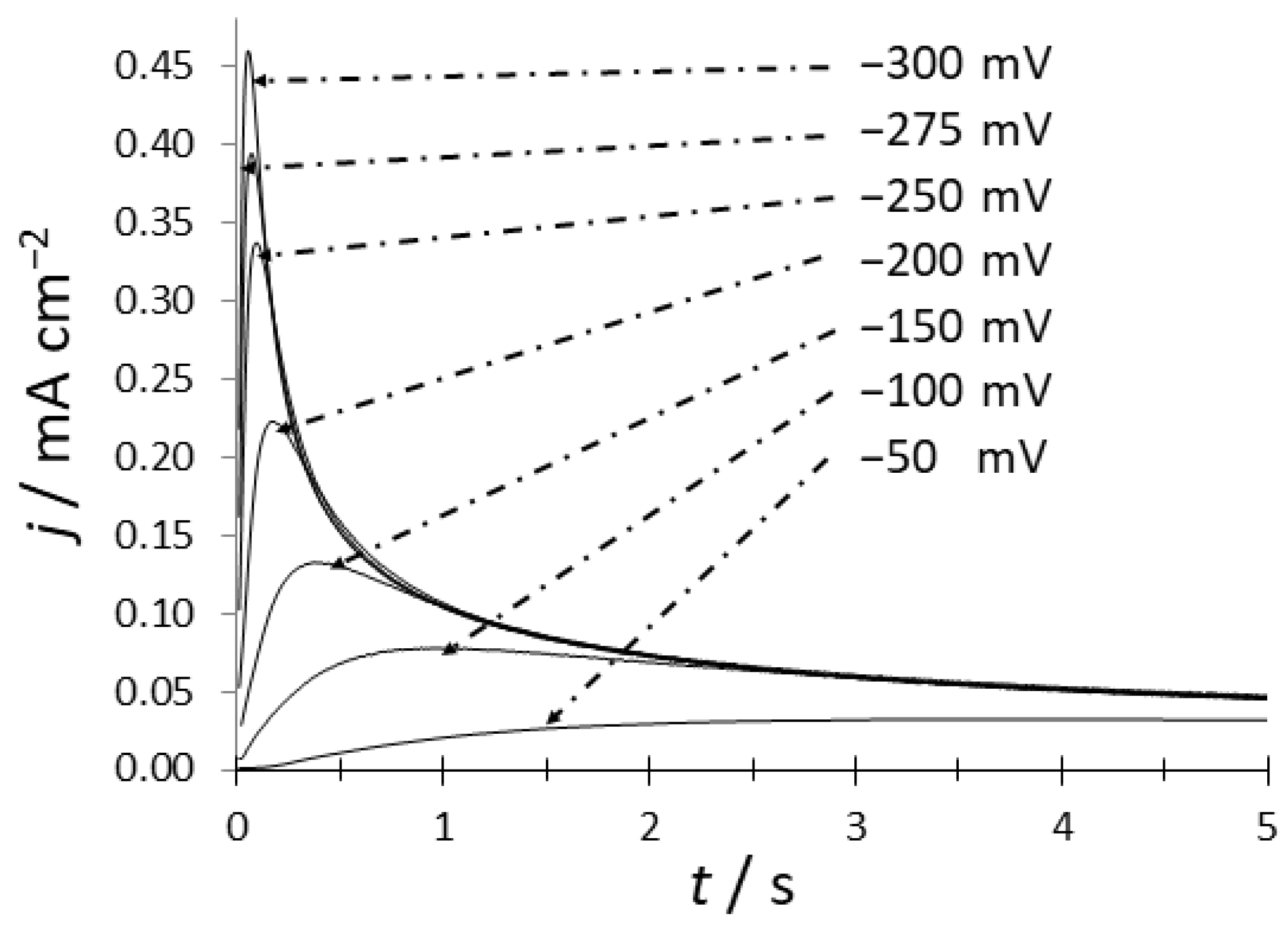

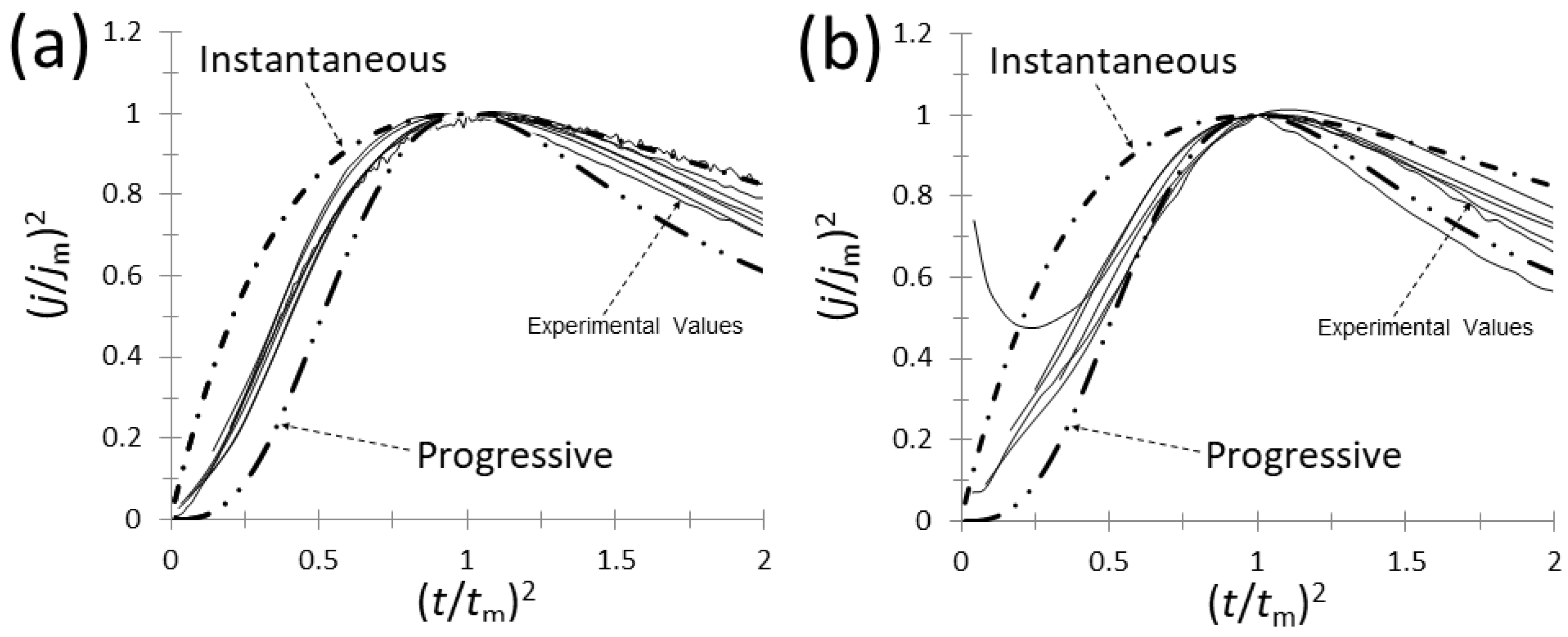
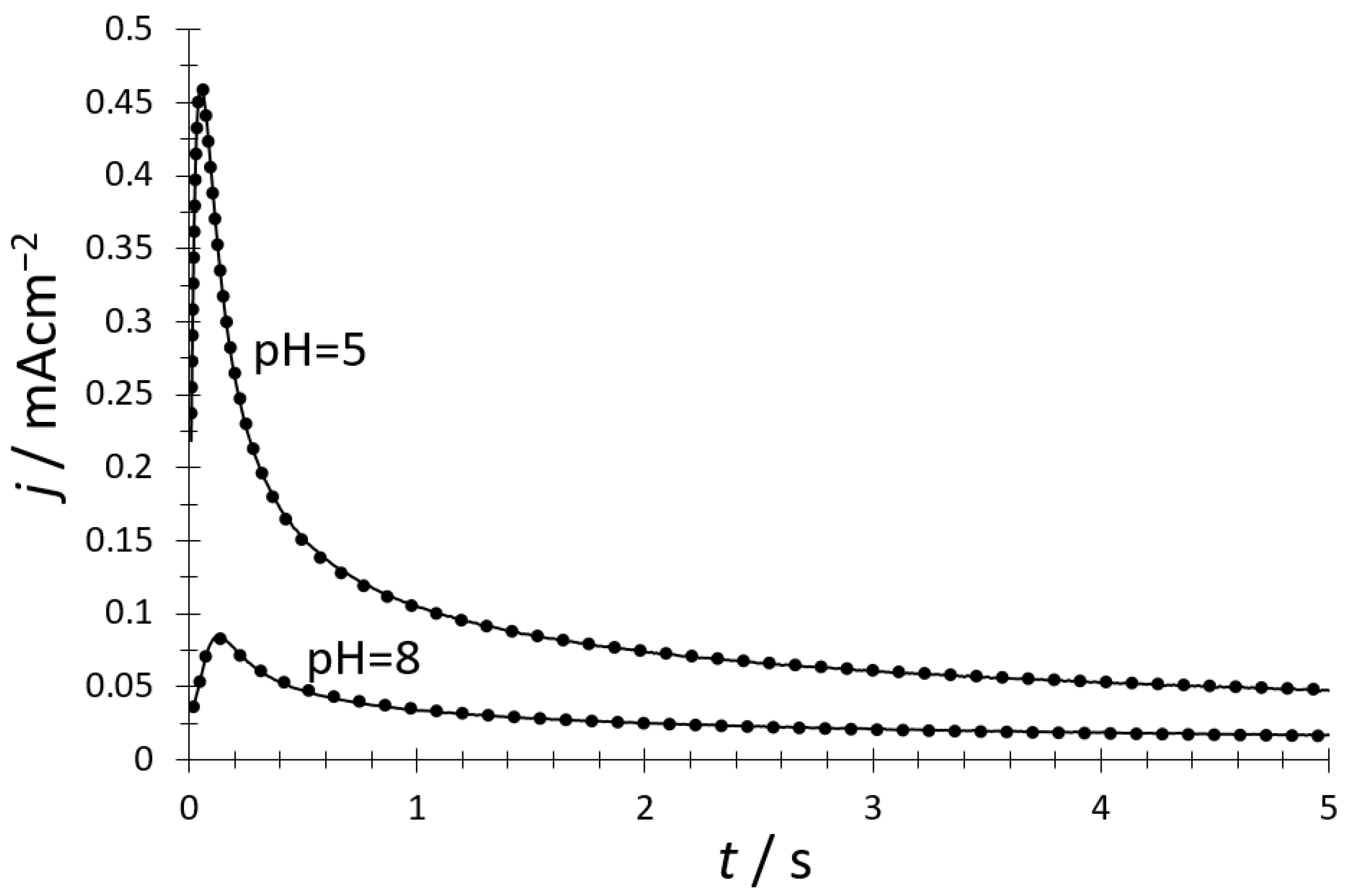
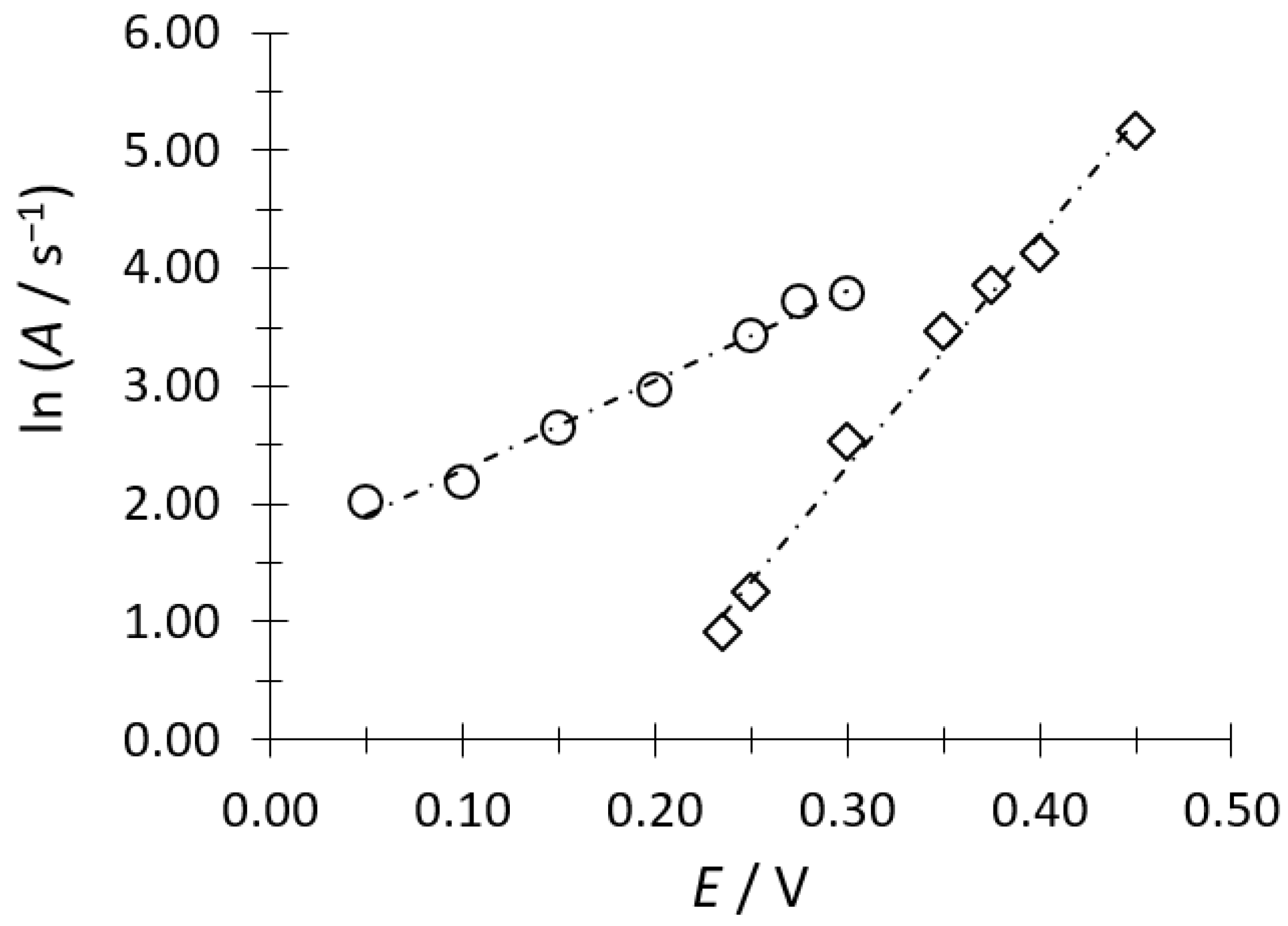
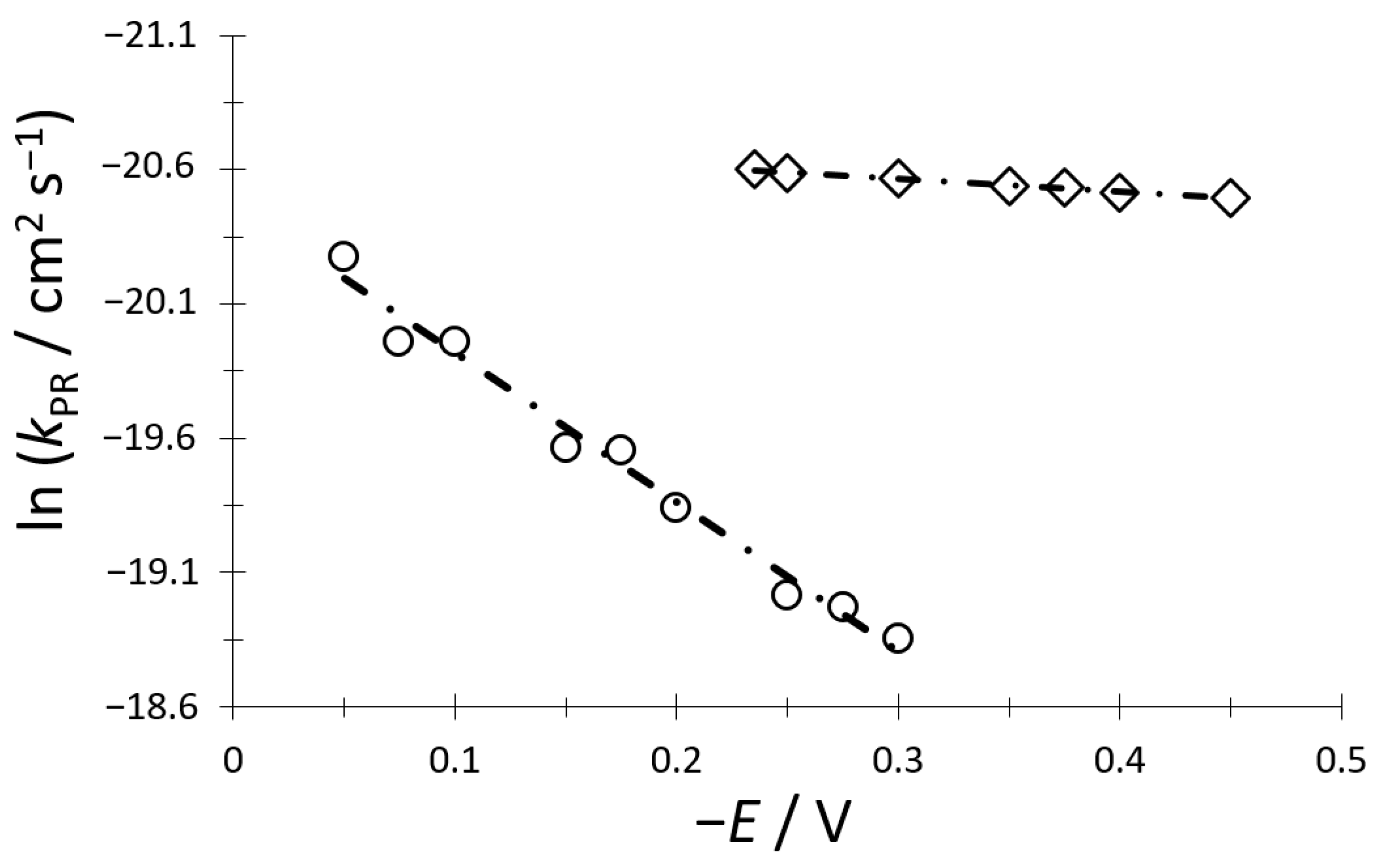
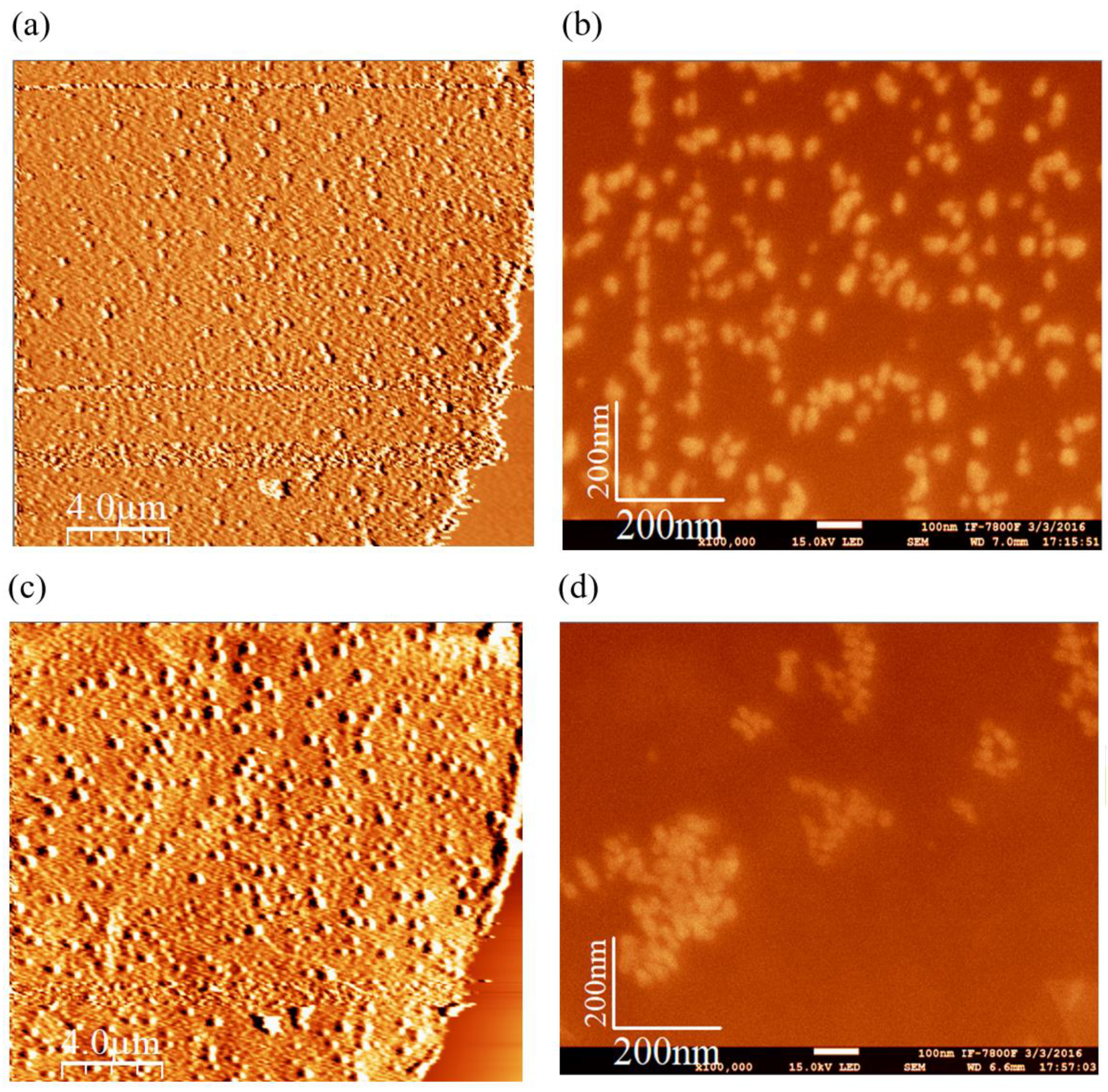
| E /V | A /s−1 | N0 × 10−9 /cm2 | D × 10−7 /cm2s−1 | kPR × 109 /cm2s−1 |
|---|---|---|---|---|
| −0.050 | 7.48 | 0.085 | 6.84 | 1.56 |
| −0.075 | 8.80 | 0.206 | 7.62 | 2.14 |
| −0.100 | 8.88 | 0.420 | 8.70 | 2.14 |
| −0.150 | 14.09 | 1.131 | 8.70 | 3.18 |
| −0.175 | 16.18 | 2.050 | 8.70 | 3.22 |
| −0.200 | 19.44 | 3.421 | 8.44 | 3.98 |
| −0.250 | 31.00 | 7.512 | 8.21 | 5.53 |
| −0.275 | 41.19 | 10.641 | 8.33 | 5.78 |
| −0.300 | 43.88 | 13.056 | 8.71 | 6.49 |
| E /V | A /s−1 | N0 × 10−9 /cm2 | D × 10−7 /cm2s−1 | kPR × 109 /cm2s−1 |
|---|---|---|---|---|
| −0.235 | 2.50 | 0.12 | 0.34 | 1.13 |
| −0.250 | 3.50 | 23.83 | 0.62 | 1.15 |
| −0.300 | 12.50 | 49.11 | 0.95 | 1.17 |
| −0.350 | 32.00 | 65.00 | 1.79 | 1.20 |
| −0.375 | 47.00 | 95.34 | 2.03 | 1.21 |
| −0.400 | 62.50 | 104.83 | 2.11 | 1.23 |
| −0.450 | 175.00 | 122.78 | 2.84 | 1.26 |
Disclaimer/Publisher’s Note: The statements, opinions and data contained in all publications are solely those of the individual author(s) and contributor(s) and not of MDPI and/or the editor(s). MDPI and/or the editor(s) disclaim responsibility for any injury to people or property resulting from any ideas, methods, instructions or products referred to in the content. |
© 2024 by the authors. Licensee MDPI, Basel, Switzerland. This article is an open access article distributed under the terms and conditions of the Creative Commons Attribution (CC BY) license (https://creativecommons.org/licenses/by/4.0/).
Share and Cite
Bravo-Rodriguez, A.S.; Mendoza-Huizar, L.H.; Rivera, M.; Álvarez-Romero, G.A. The Effect of pH on the Electrodeposition of Pd Clusters onto Highly Ordered Pyrolytic Graphite—A Kinetic and Morphological Study. C 2024, 10, 55. https://doi.org/10.3390/c10020055
Bravo-Rodriguez AS, Mendoza-Huizar LH, Rivera M, Álvarez-Romero GA. The Effect of pH on the Electrodeposition of Pd Clusters onto Highly Ordered Pyrolytic Graphite—A Kinetic and Morphological Study. C. 2024; 10(2):55. https://doi.org/10.3390/c10020055
Chicago/Turabian StyleBravo-Rodriguez, Adrian Said, Luis Humberto Mendoza-Huizar, Margarita Rivera, and Giaan Arturo Álvarez-Romero. 2024. "The Effect of pH on the Electrodeposition of Pd Clusters onto Highly Ordered Pyrolytic Graphite—A Kinetic and Morphological Study" C 10, no. 2: 55. https://doi.org/10.3390/c10020055
APA StyleBravo-Rodriguez, A. S., Mendoza-Huizar, L. H., Rivera, M., & Álvarez-Romero, G. A. (2024). The Effect of pH on the Electrodeposition of Pd Clusters onto Highly Ordered Pyrolytic Graphite—A Kinetic and Morphological Study. C, 10(2), 55. https://doi.org/10.3390/c10020055






